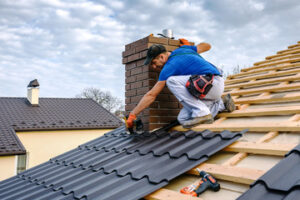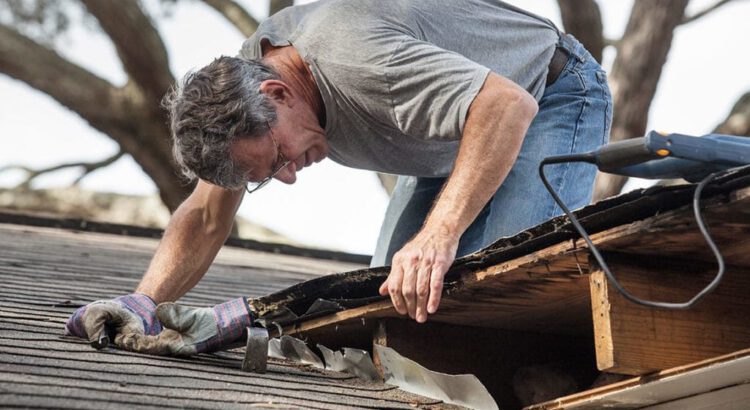Many different roof designs can be used for a building, each providing benefits. These can include a style that showcases skylights, windows, dormers, or another feature.
5R Roofing for example, has two sloped sides that meet at a ridge and can be either open or boxed off. They’re good for areas that get a lot of snow and rain.

A gable roof is one of the most common types of roofs found in residential construction. It consists of two roofing planes that meet at a ridge in the center and can either be steep or shallow. This design is ideal for shedding precipitation, as water and snow will easily slide off rather than pooling. Additionally, gable roofs are typically easier to construct than other roof styles and can be more affordable.
Another advantage of a gable roof is that it creates a more open and spacious interior, making a home look bigger. The sloping sides of the top also allow for vaulted ceilings, making rooms feel much more airy and comfortable. However, if your home has a gable roof with a shallow pitch angle, you may need help building a loft or other room underneath the top to add extra living space.
A downside of a gable roof is its steep sloping angles, which can cause it to be more prone to damage from heavy snow or rain. In areas with extreme weather conditions, it’s important to reinforce your gable roof or switch to a more stable type of roof. Additionally, a flexible roof is less insulated than other types of roofs. That means that your home will be less energy efficient and may require more heating or cooling during the colder months.
While hip roofs are less common than gable roofs, they offer many benefits. For one, they are very durable and can withstand extreme weather conditions, including heavy rain, snow, and wind. The sloping sides of this type of roof help prevent water, sleet, and melting snow from building up and weighing down the structure. They also allow for natural ventilation and can provide additional living space.
There are several types of hip roofs, and they can vary in size depending on the structure’s layout. A standard hip roof features four sloped sides that meet in the middle, creating a peak or ridge. Other types of hip roofs include the pyramid hip and the cross-hipped roof. A pyramid hip has four equal sloped sides that form a pyramid shape on the top of a home, while the cross-hipped roof features two hips intersecting with a gable roof.
Hip roofs are self-bracing, and their sloped sides help to block strong winds. This design makes them ideal for homes in hurricane-prone areas, as they can withstand high currents with minimal damage. Additionally, hip roofs can be easier to work on than gable roofs since there are no exposed vertical walls and less material is needed for support.
However, the main disadvantage of this roof style is that it requires more materials than other roof designs. That means it can cost more to construct and shingle, making it more expensive than a gable roof. In addition, a hip roof can make it difficult to install solar panels, as the panels need ample space to absorb sunlight. For this reason, it’s important to speak with a professional roofer about your roof options before deciding on the best structure for your house. They can recommend the best roof type for your specific climate and building layout. With the right knowledge, you can create a roof that protects your house from all the elements and provides you with the most comfortable living space possible. Contact us today to learn more about the different types of roofs and how they can affect your home’s energy efficiency.
The A-frame roof is the perfect architectural feature for rustic and cozy cabins. This distinctive design has been coming back in recent years and can be seen in vacation homes, chalets, and cottages worldwide. But despite its charm, this unique home style comes with some quirks that buyers need to be aware of.
A-frame houses are named for their distinct symmetry, with sloped sides that form two of the house’s walls. The roof also tapers off to a peak at the second (and sometimes third) floor, creating angles not usually found in traditional homes. With large windows and high ceilings, these houses offer spacious interiors and natural light.
One of the biggest advantages of an A-frame roof is its ability to provide natural drainage, preventing snow and rain from building up on the structure and reducing the risk of damage. Its steep pitch also makes it an ideal roofing solution for snowy climates, as it allows precipitation to slide off the roof easily and reduces the likelihood of ice dams.
The A-frame roof’s angled shape is also good for energy efficiency, allowing heat to move throughout the home easily. That can help keep the space warm during colder months and reduce energy costs. The unique appearance of an A-frame home can also increase its curb appeal and make it stand out from the rest of the neighborhood.
Another advantage of an A-frame roof is its simple construction process. Because the structure doesn’t need load-bearing walls, it can be built much faster than other structures. That can also lead to cost savings and a greener build process.
However, a drawback of the A-frame roof is its limited usable space. The angled structure can limit the area in an attic or second-story, which can be problematic for homeowners with large families or those who want to expand their living spaces. Also, the slanted walls and ceiling can cause people to bump their heads frequently in smaller A-frame homes. Luckily, this can be overcome by using creative storage solutions or adding dormers without altering the house’s original design.
The M-shaped roof is like a combination of the Gable and Hip roof styles. It has a high slope on two sides that meet at the center to form an “M.” You will see this roof style most often on multi-family houses and some newer homes, but it is also found in some single-family house designs. This design can add extra living space to your home and offers more protection from harsh weather.
It is more structurally complex than other roof designs and can be expensive. It can also have more leaks because of the multiple seams. However, if you’re looking for a unique roof design, the M-shaped roof is worth considering.
A cross-hipped roof is a variation of the simple hip roof with an additional structure. This structure is made of rafters that are joined together to create a cross-like shape at the top of the roof. That allows for more window installation options and makes fitting a loft extension or an attic easier.
Another roof option is a garret. That is a French roof style with a shallow slope above a steeper one at the eaves. These roofs are popular in older French buildings and can add character and interest to a home.
You can even incorporate the M-shaped roof into your home with a Saltbox Roof. That is a unique roof design that combines a few different types of ceilings to make a unique style that can be seen in some old New England homes. It can give your home a classic look and is great for keeping the heat inside in winter.
Gable roofs are a common design that is easy to build and has good protection from weather. They have two side slope parts that join at the ridge point and can be angled from 7 to 35 degrees. They are also known as peaked roofs and are popular for homes in cold climates. The sloping sides of a gable roof protect the lower part of the house from rain, snow, and strong winds. The slant of the roof helps the water flow off into gutters easily.
